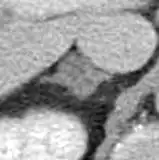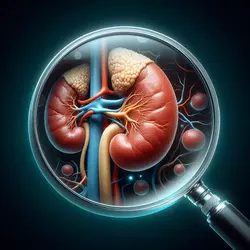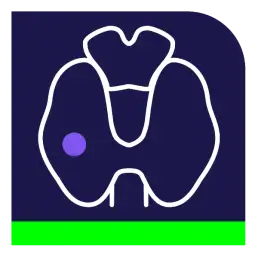Adrenal Washout Calculator & Report Generator for CT
Reference:
Related Calculators:

More about the Adrenal Washout calculator:
Adrenal washout is a specialized imaging technique used in computed tomography (CT) to evaluate adrenal masses and determine their potential clinical significance. This method calculates the percentage of contrast material retained by a lesion over time, helping to differentiate between benign and malignant adrenal nodules. This distinction is crucial, as it directly impacts patient management strategies, including whether to pursue surveillance, additional diagnostic testing, or surgical intervention.
What Are Adrenal Nodules?
Adrenal nodules, are masses discovered during imaging studies conducted for unrelated reasons. They are common findings, with a prevalence of up to 4% in imaging studies. While most adrenal nodules are non-functional and benign, a small percentage can be malignant or hormonally active, requiring timely evaluation and management. The ability to accurately characterize these nodules non-invasively is one of the great challenges of modern radiology.
The importance of identifying the nature of adrenal nodules lies in the diversity of their potential causes. These include:
- Adrenal Adenomas: Benign and often lipid-rich, these are the most common type of adrenal nodules.
- Adrenal Carcinomas: Rare but aggressive cancers originating from the adrenal cortex.
- Metastases: Malignant deposits in the adrenal glands, often secondary to primary cancers such as lung or breast cancer.
- Pheochromocytomas: Tumors arising from adrenal medulla that may secrete excess catecholamines.
- Other Lesions: Including myelolipomas, cysts, and hemorrhages.
How Adrenal Washout CT Works
The adrenal washout technique leverages the differences in contrast retention between benign and malignant lesions. When contrast material is injected during a CT scan, it enhances the tissues based on their vascularity and cellular composition. By measuring the attenuation (density) of a lesion at specific time points, its washout pattern can be determined:
- Unenhanced Attenuation: Reflects the lesion's baseline density before contrast administration.
- Contrast-Enhanced Attenuation: Measured shortly after the injection of contrast, capturing the lesion's peak enhancement.
- Delayed Attenuation: Acquired several minutes after contrast injection, indicating the rate of washout.
Using these values, two washout percentages are calculated:
- Absolute Washout Percentage (AWP): A measure of how much contrast has been cleared compared to the pre-contrast state.
- Relative Washout Percentage (RWP): A measure of how much contrast has been cleared relative to the peak enhancement.
Diagnostic Thresholds
Washout percentages are interpreted using well-established thresholds:
- Benign Adenomas: High washout percentages (AWP ≥ 60% or RWP ≥ 40%).
- Malignant Lesions: Low washout percentages, suggesting slower contrast clearance and necessitating further evaluation.
These thresholds provide a reliable method for distinguishing between lipid-rich adenomas and other adrenal masses. However, it is important to consider the entire clinical and imaging context to avoid misdiagnosis.
Clinical Relevance
The introduction of adrenal CT analysis has transformed the evaluation of adrenal nodules, offering a safe and efficient alternative to invasive procedures like biopsies. By reducing diagnostic uncertainty, it allows for better stratification of patients who need further evaluation or treatment.
In cases of benign adenomas with clear adrenal imaging features, patients can avoid unnecessary follow-up imaging, reducing healthcare costs and psychological stress. On the other hand, identifying indeterminate or suspicious lesions enables timely intervention, potentially saving lives in cases of malignancy.
Technical Considerations
Proper application of analysis with adrenal washout CT calculator requires strict adherence to imaging protocols:
- Consistent Timing: Delayed imaging must occur at the standardized 10-15 minute interval.
- Accurate Measurement: Regions of interest (ROIs) must be carefully placed to avoid including cystic or necrotic areas.
- Standardized Contrast Dosing: Variations in dose can impact enhancement patterns.
Radiologists must also consider patient factors such as renal function, which can influence contrast clearance and potentially alter washout calculations.
Limitations
While highly effective, adrenal washout CT analysis is not infallible. Some lesions, such as pheochromocytomas or atypical adenomas, may mimic the washout patterns of malignant lesions, leading to diagnostic uncertainty. Additionally, very small nodules may be challenging to measure accurately, increasing the likelihood of errors.
Overlapping washout patterns between benign and malignant lesions also highlight the importance of integrating imaging findings with clinical and laboratory data. In some cases, additional imaging modalities such as MRI or functional imaging (e.g., PET-CT) may be required for a definitive diagnosis.
Emerging Trends
Advances in imaging technology continue to refine adrenal nodule evaluation. Dual-energy CT and radiomics are promising areas of research that may enhance the diagnostic accuracy of adrenal washout analysis. These techniques leverage advanced data processing and artificial intelligence to extract additional biomarkers from imaging studies, offering new insights into lesion characterization.
Furthermore, the increasing integration of imaging data into multidisciplinary care highlights the role of radiology in personalized medicine. Collaborative approaches involving endocrinologists, surgeons, and oncologists ensure that patients receive comprehensive and individualized care.
Conclusion
Adrenal washout analysis exemplifies the power of quantitative imaging in modern radiology. By providing a reliable, non-invasive method for differentiating adrenal lesions, it improves diagnostic confidence and patient outcomes. As imaging techniques evolve, the principles of adrenal washout analysis will likely inspire further innovations, reinforcing its value in clinical practice.




forever grateful in your for your contributions!